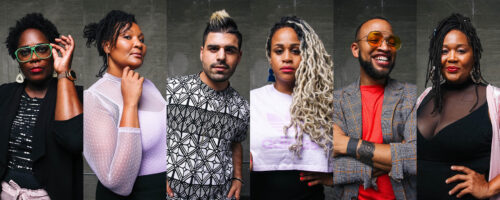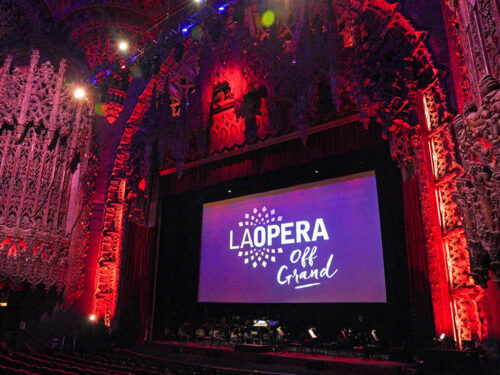COME IN TO GET OUT
In an immensely satisfying Halloween entertainment, Jordan Peele’s splendid thriller, Get Out, was accompanied by the LA Opera Orchestra playing the score live under the baton of the composer Michael Abels.
Composer/conductor Michael Abels conducts "Get Out with Live Orchestra" (taken on opening night, October 29, 2021 by Lawrence K. Ho)
This is a fascinating process whereby the music track is stripped from the film and a live orchestra plays the score precisely as it is in the movie. The conductor works to a time-marked copy of the film playing on a monitor before his podium. More than mere novelty, the joy of seeing the orchestra ranged across the stage, beneath the screen, and hearing the score given a presence that even the most sophisticated sound system cannot achieve is pretty special.
Betty Gabriel in Jordan Peele's 2017 film "Get Out"
Get Out is a masterpiece of subtly advancing horror capped with gory revenge so justified that Friday’s packed audience cheered every bloody stroke vociferously. Get Out won a totally justified Oscar for Jordan Peele’s screenplay. There is no padding, no wasted moment in the writing or direction; every word, visual, and glance furthers the plot. It is an object lesson to all writers on how to advance the story with only essential information. Yet, character, exposition, backstory are artfully established without once bringing the action to a halt.
Daniel Kaluuya and Allison Williams (seated) in Jordan Peele's 2017 film "Get Out"
The suspense creeps up on one gradually, one fragment of the mystery at a time. There is none of the usual stuff of the hackneyed slasher pics of today: no one leaps suddenly from behind a closed door, no glimpse in a mirror of the monster lurking behind the leading character, no idiot hero wanders into a darkened cellar and asks “Is anyone there?” only to have a zombie take a bite out of him. The sole exception to the overall subtlety is one utterly unexpected jolt in his first act which startles, and keeps us alert for what may come. This is a calculation of the kind Hitchcock often made in his story construction – disorient the audience early on, and they’ll be held in thrall for the duration. There’s no better example of this trick than Janet Leigh’s demise in Psycho. And, to balance the tingling suspense, there’s comedy, of course, to offer relief, but never at the expense of narrative.
Not counting his shot at scoring a film in his student days at USC, this is Michael Abels’ first foray into composing for a commercial movie. His “serious” compositions are widely diverse – classical, pop, hip hop, and are performed throughout the United States. But at a time when many movie scores have become pedestrian drones that describe neither action nor character, his score goes for mood. As subtle as the film, his gently persuasive tracks are edged with eeriness. Rather than giving us the hackneyed “sting” of the kind that adds a musical sledgehammer to some horrific moment, Abels gives us something more subtly disorienting, occasionally employing other-worldly Swahili vocals which seem to italicize the African-American perceptions and misperceptions which are at the heart of the story. Whether swirling strings, plucked strings, tapped instruments, or a sound as simple as a repeated note from a triangle – every musical passage enhances its scene without obtruding.
Members of the LA Opera orchestra. (Lawrence K. Ho)
Add to all the above the brilliance and precision of the LA Opera Orchestra and the DC6 Singers. There’s no praise I can offer this orchestra which has not been bestowed often before. In the thirty years I’ve been attending the LA Opera, the standard of the orchestra has never flagged for so much as a semi quaver. The addition of the wonderful DC6 Singers added an extra dimension. Not only was their Swahili beyond reproach, but their clever rendition of the British World War II ditty “Run, Rabbit, Run” would’ve delighted its originators, Flannagan and Allen.
The Theatre At Ace Hotel
Finally, the venue: The Theater at the Ace Hotel, formerly the United Artists Theater, was established in 1927 by silent megastars, Douglas Fairbanks, Mary Pickford, Charlie Chaplin and director D.W. Griffith. It is a miracle of both cinema architecture and of preservation. Between 1990 and 2011 it was the home of the University Cathedral, an evangelical group who held Sunday services in it. A neon above the entrance proclaimed “Jesus Saves”. To their credit, those whom Jesus saved in turn saved the theater. Unlike other movie palaces in downtown LA where religious groups desecrated similar motion picture temples by whitewashing over the elaborate interior plaster work, the United Artists survived this indignity.
It is such a pleasure to be in this theater for this kind of event, I personally wish Halloween popped up more frequently than once a year.
Members of the LA Opera orchestra. (Lawrence K. Ho)



